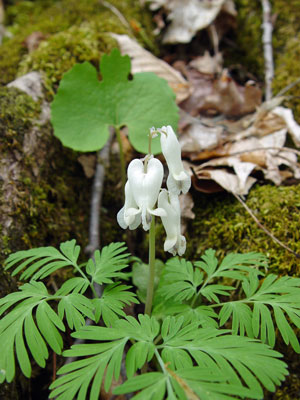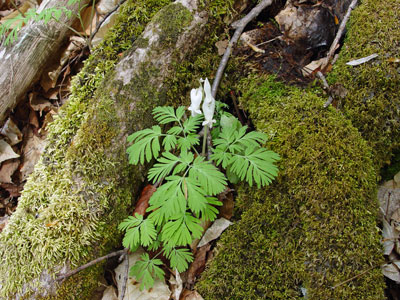DACF Home → Bureaus & Programs → Maine Natural Areas Program → Communities, Plants, and Animals → Rare Plants → Dicentra canadensis

Dicentra canadensis(Goldie) Walp.
Squirrel-corn
- State Rank: S1
- Global Rank: G5
- State Status: Endangered
Habitat: Rich woods, cave forests with sugar maple and often ash and/or basswood. [Hardwood to mixed forest (forest, upland)].
Range: Southwest Quebec to Minnesota, south to New England, North Carolina, and west to Missouri.
Aids to Identification: The finely cut foliage and succulent stems of squirrel-corn are indistinguishable from Dutchman's breeches, D. cucullaria, but the flowers and tubers are different. The fragrant flowers of D. canadensis have very rounded, as opposed to pointed, lobes, and the shallow tubers look like yellow grains of corn; whereas D. cucullaria has clusters of smaller, pink corms.

Ecological characteristics: Squirrel-corn grows in rich, moist woods, sometimes with soils derived from calcic rocks. It has been suggested in the literature that the seeds are ant-dispersed.
Phenology: Flowers in early spring along with hepatica, bloodroot, and dogtooth violet.
Family: Papaveraceae
Synonyms: Bicuculla canadensis (Goldie) Millsp.; Capnorchis canadensis (Goldie) Kuntze; Corydalis canadensis Goldie.
Known Distribution in Maine: This rare plant has been documented from a total of 6 town(s) in the following county(ies): Franklin, Oxford, Penobscot
Reason(s) for rarity: Unknown, scarcity of suitable habitat?
Conservation considerations: Effects of logging are unknown, but partial removal of the canopy would be less likely to adversely affect the plant than complete removal.